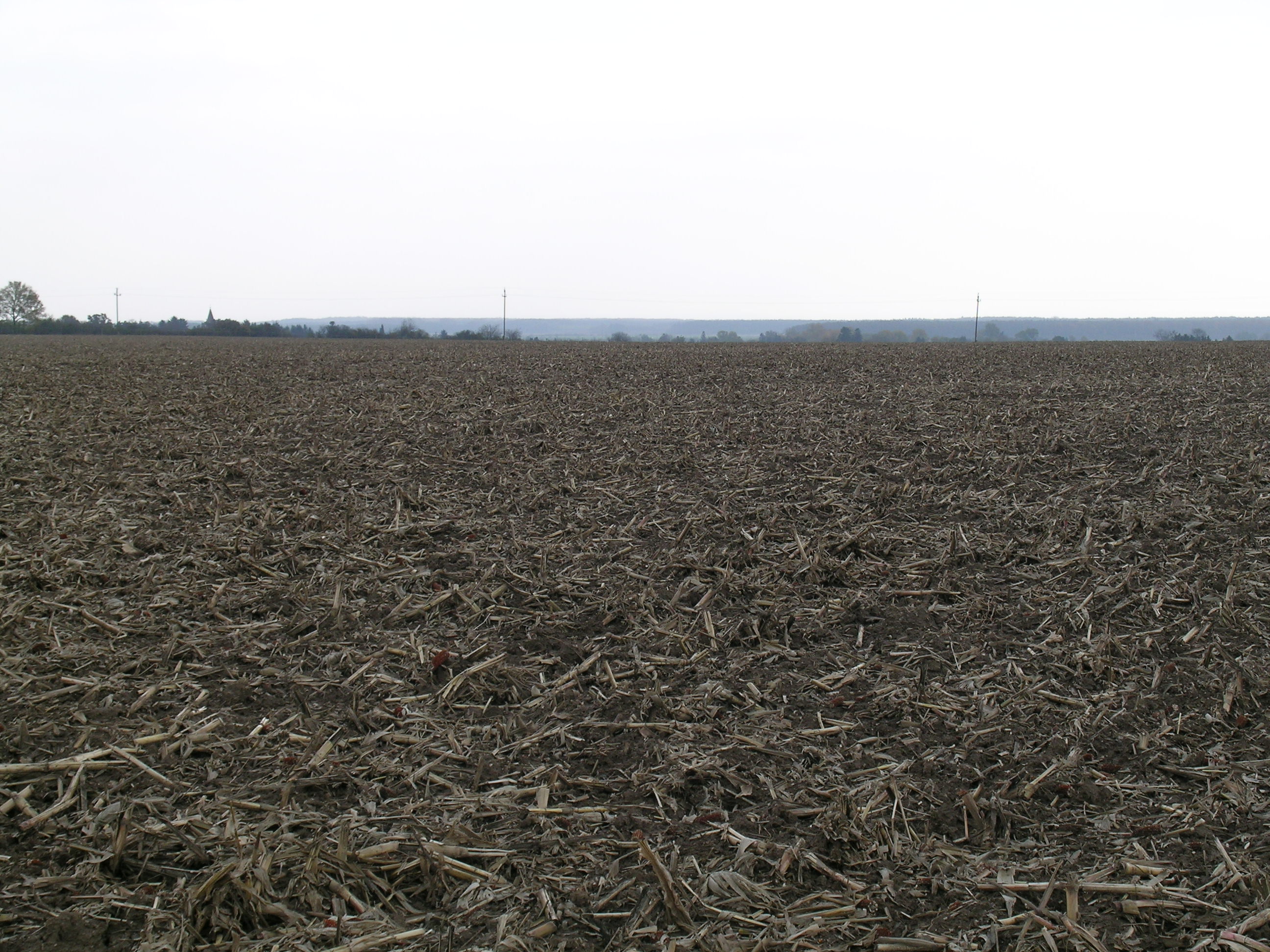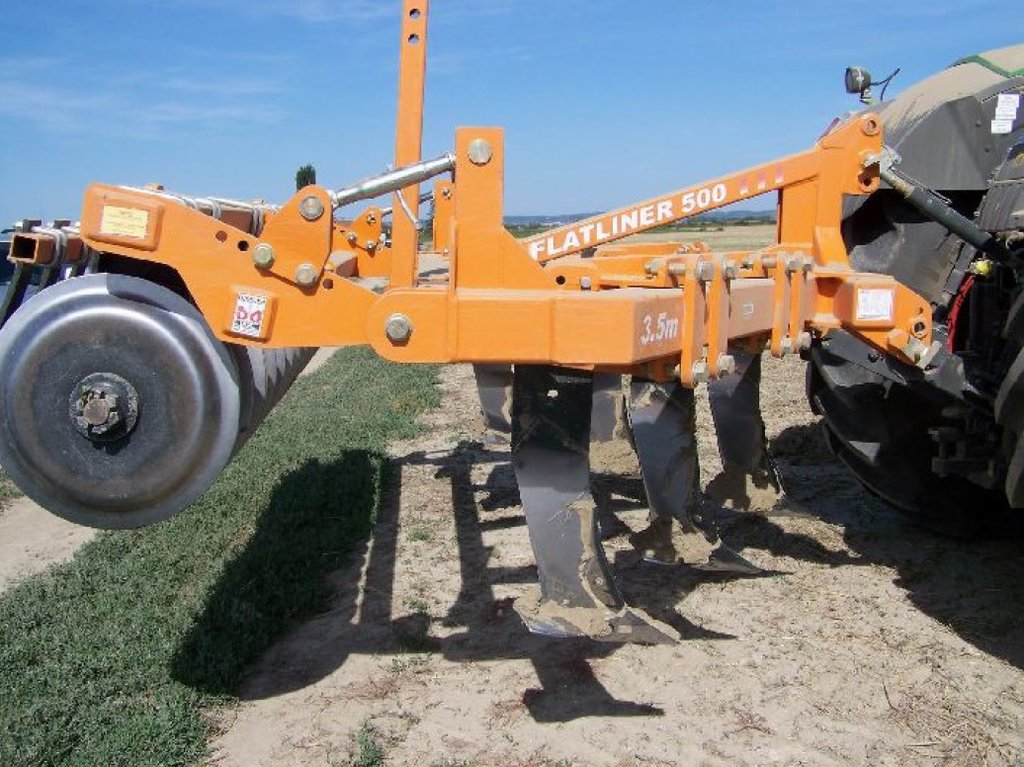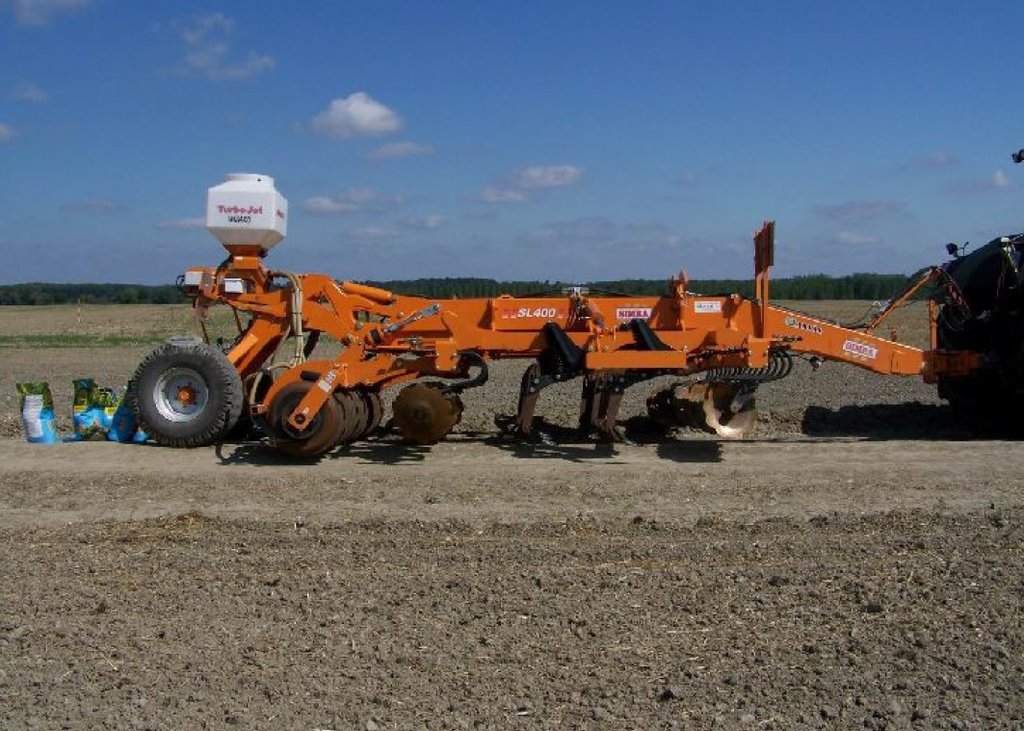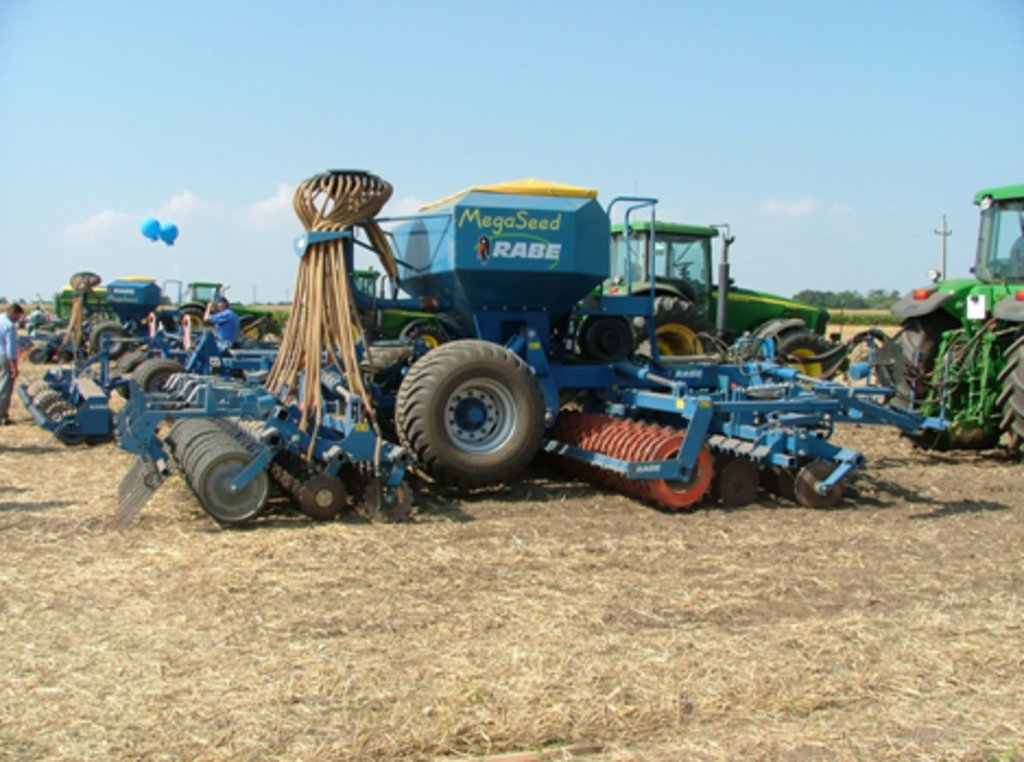Conservation tillage [Hungary]
- Creation:
- Update:
- Compiler: Brigitta Toth
- Editor: –
- Reviewers: Ursula Gaemperli, Gudrun Schwilch
Csökkentett és talajkímélő művelés
technologies_3065 - Hungary
View sections
Expand all Collapse all1. General information
1.2 Contact details of resource persons and institutions involved in the assessment and documentation of the Technology
Name of project which facilitated the documentation/ evaluation of the Technology (if relevant)
Interactive Soil Quality assessment in Europe and China for Agricultural productivity and Environmental Resilience (EU-iSQAPER)Name of the institution(s) which facilitated the documentation/ evaluation of the Technology (if relevant)
Department of Crop Production and Soil Science, University of Pannonia - Hungary1.3 Conditions regarding the use of data documented through WOCAT
When were the data compiled (in the field)?
27/10/2016
The compiler and key resource person(s) accept the conditions regarding the use of data documented through WOCAT:
Ja
1.4 Declaration on sustainability of the described Technology
Is the Technology described here problematic with regard to land degradation, so that it cannot be declared a sustainable land management technology?
Nee
Comments:
-
1.5 Reference to Questionnaire(s) on SLM Approaches
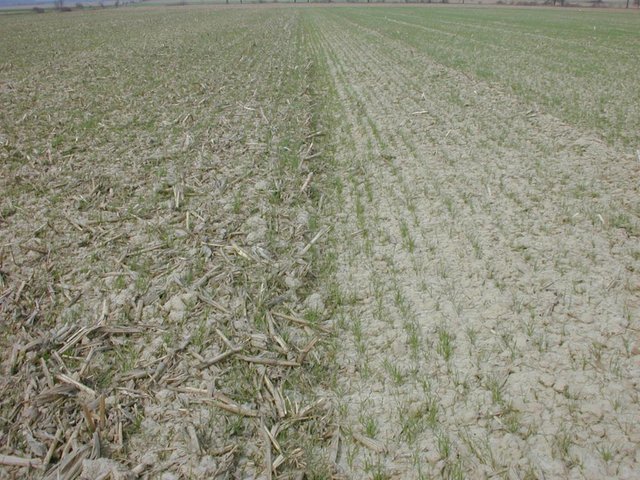
Conservation tillage [Hungary]
Non inversion, conservation (soil and water protective) tillage.
- Compiler: Adam Kertesz
2. Description of the SLM Technology
2.1 Short description of the Technology
Definition of the Technology:
The aim of conservation tillage is to reduce the soil disturbance. It decreases decomposition of organic matter, enhances cycling of nutrients, soil structure and increases water infiltration.
2.2 Detailed description of the Technology
Description:
1. The case study area is situated within the catchment of river Zala in western Hungary. The climate is moderately warm, moderately humid, the number of sunshine hours per year are high. Mean annual temperature of the region is about 10 ˚C. The average amount of rainfall is between 600 and 700 mm / year. 37% of the total catchment area is arable land which is much lower than the national average, 27% is forest, which exceeds the national average. 15% of the land is under grassland management, 5% is horticulture, 3% is pomiculture, 2% is viticulture, 1% is reed management and fish farming. In arable land non irrigated cereals, maize and oil crops are the main farming system classes. Among permanent crops vineyard and fruit trees are the most significant.
2. In this technology reduced disturbance of the soil is used, non-inversion of soil is applied. At least 30 percent of crop residues are left on the field. Primary tillage is usually carried out by rippers or combinated disk rippers. Machinery is usually supplied by agricultural contractors in case of farms smaller than 100 ha.
3. The purpose of the technology is to improve soil structure, reduce decomposition of organic matter, increase water infiltration, reduce soil erosion and soil compaction.
4. Special equipment is needed for soil management: soil loosener and minimum-tillage equipment to perform tillage and seeding in one pass. Primary tillage is due in autumn, secondary tillage (surface preparation) is performed in early spring.
5. It improves soil microbial activity, biodiversity, deeper rooting. Further to it fuel efficiency is better compared to conventional tillage.
6. Its disadvantage is the higher risk of weed infestation.
2.3 Photos of the Technology
2.5 Country/ region/ locations where the Technology has been applied and which are covered by this assessment
Country:
Hungary
Region/ State/ Province:
Zala
Further specification of location:
Rádóckölked
Comments:
-
Map
×2.6 Date of implementation
Indicate year of implementation:
2002
2.7 Introduction of the Technology
Specify how the Technology was introduced:
- through land users' innovation
Comments (type of project, etc.):
-
3. Classification of the SLM Technology
3.1 Main purpose(s) of the Technology
- improve production
- reduce, prevent, restore land degradation
- create beneficial economic impact
3.2 Current land use type(s) where the Technology is applied

Cropland
- Annual cropping
Main crops (cash and food crops):
wheat, maize, oilseed rape
Comments:
-
If land use has changed due to the implementation of the Technology, indicate land use before implementation of the Technology:
Remained the same.
3.3 Further information about land use
Water supply for the land on which the Technology is applied:
- rainfed
Comments:
-
Number of growing seasons per year:
- 1
Specify:
From 18-23 April till 14-16 October
Livestock density (if relevant):
-
3.4 SLM group to which the Technology belongs
- minimal soil disturbance
3.5 Spread of the Technology
Specify the spread of the Technology:
- applied at specific points/ concentrated on a small area
3.6 SLM measures comprising the Technology

agronomic measures
- A2: Organic matter/ soil fertility
- A3: Soil surface treatment
- A4: Subsurface treatment
Comments:
-
3.7 Main types of land degradation addressed by the Technology

soil erosion by water
- Wt: loss of topsoil/ surface erosion

physical soil deterioration
- Pc: compaction
- Pw: waterlogging

biological degradation
- Bs: quality and species composition/ diversity decline
3.8 Prevention, reduction, or restoration of land degradation
Specify the goal of the Technology with regard to land degradation:
- prevent land degradation
4. Technical specifications, implementation activities, inputs, and costs
4.1 Technical drawing of the Technology
4.2 Technical specifications/ explanations of technical drawing
This turbo drill machine used in this conservation tillage technology perform seedbed preparation and sowing in one operation.
4.3 General information regarding the calculation of inputs and costs
Specify how costs and inputs were calculated:
- per Technology area
Indicate size and area unit:
1 hectare
other/ national currency (specify):
Forint
Indicate exchange rate from USD to local currency (if relevant): 1 USD =:
257.0
Indicate average wage cost of hired labour per day:
10000
4.6 Maintenance/ recurrent activities
| Activity | Type of measure | Timing/ frequency | |
|---|---|---|---|
| 1. | Primary tillage (Seedbed preparation and sowing) | Agronomic | autumn |
Comments:
Compared to conventional tillage no further activities are required in conventional tillage. Primary tillage is indicated because it needs different equipment, such as ripper or disk ripper.
4.7 Costs and inputs needed for maintenance/ recurrent activities (per year)
| Specify input | Unit | Quantity | Costs per Unit | Total costs per input | % of costs borne by land users | |
|---|---|---|---|---|---|---|
| Labour | primary tillage | day/ha | 0.1 | 15000.0 | 1500.0 | 100.0 |
| Equipment | primary tillage machine (0.67 hour 1 ha) | machine hours | 0.67 | 14570.0 | 9761.9 | 100.0 |
| Total costs for maintenance of the Technology | 11261.9 | |||||
Comments:
Cost of primary tillage in conventional tillage would cost 38200 Ft (equipment: 35200 Ft + labour: 3000 Ft). Therefore primary tillage costs 27000 Ft/ha less in conservation tillage than in conventional tillage.
It might be needed to use wider range herbicides for killing higher number of weed species, which can cost extra 10000 Ft/ha.
4.8 Most important factors affecting the costs
Describe the most determinate factors affecting the costs:
Cost of pesticides can be higher than in conventional tillage, but cost of fuel is significantly less.
5. Natural and human environment
5.1 Climate
Annual rainfall
- < 250 mm
- 251-500 mm
- 501-750 mm
- 751-1,000 mm
- 1,001-1,500 mm
- 1,501-2,000 mm
- 2,001-3,000 mm
- 3,001-4,000 mm
- > 4,000 mm
Specifications/ comments on rainfall:
-
Indicate the name of the reference meteorological station considered:
Rádóckölked
Agro-climatic zone
- sub-humid
moderately cool, moderately wet
5.2 Topography
Slopes on average:
- flat (0-2%)
- gentle (3-5%)
- moderate (6-10%)
- rolling (11-15%)
- hilly (16-30%)
- steep (31-60%)
- very steep (>60%)
Landforms:
- plateau/plains
- ridges
- mountain slopes
- hill slopes
- footslopes
- valley floors
Altitudinal zone:
- 0-100 m a.s.l.
- 101-500 m a.s.l.
- 501-1,000 m a.s.l.
- 1,001-1,500 m a.s.l.
- 1,501-2,000 m a.s.l.
- 2,001-2,500 m a.s.l.
- 2,501-3,000 m a.s.l.
- 3,001-4,000 m a.s.l.
- > 4,000 m a.s.l.
Indicate if the Technology is specifically applied in:
- not relevant
Comments and further specifications on topography:
-
5.3 Soils
Soil depth on average:
- very shallow (0-20 cm)
- shallow (21-50 cm)
- moderately deep (51-80 cm)
- deep (81-120 cm)
- very deep (> 120 cm)
Soil texture (topsoil):
- medium (loamy, silty)
Soil texture (> 20 cm below surface):
- medium (loamy, silty)
Topsoil organic matter:
- medium (1-3%)
If available, attach full soil description or specify the available information, e.g. soil type, soil PH/ acidity, Cation Exchange Capacity, nitrogen, salinity etc.
Luvisol; pH is 6.5.; CEC = 20 cmol(+)/kg
5.4 Water availability and quality
Ground water table:
< 5 m
Availability of surface water:
good
Water quality (untreated):
poor drinking water (treatment required)
Is water salinity a problem?
Nee
Is flooding of the area occurring?
Nee
Comments and further specifications on water quality and quantity:
-
5.5 Biodiversity
Species diversity:
- medium
Habitat diversity:
- medium
Comments and further specifications on biodiversity:
-
5.6 Characteristics of land users applying the Technology
Sedentary or nomadic:
- Sedentary
Market orientation of production system:
- commercial/ market
Off-farm income:
- less than 10% of all income
Relative level of wealth:
- average
Individuals or groups:
- groups/ community
Level of mechanization:
- mechanized/ motorized
Gender:
- men
Age of land users:
- middle-aged
Indicate other relevant characteristics of the land users:
-
5.7 Average area of land owned or leased by land users applying the Technology
- < 0.5 ha
- 0.5-1 ha
- 1-2 ha
- 2-5 ha
- 5-15 ha
- 15-50 ha
- 50-100 ha
- 100-500 ha
- 500-1,000 ha
- 1,000-10,000 ha
- > 10,000 ha
Is this considered small-, medium- or large-scale (referring to local context)?
- medium-scale
Comments:
-
5.8 Land ownership, land use rights, and water use rights
Land ownership:
- company
- individual, titled
Land use rights:
- leased
- individual
Water use rights:
- leased
Comments:
-
5.9 Access to services and infrastructure
health:
- poor
- moderate
- good
education:
- poor
- moderate
- good
technical assistance:
- poor
- moderate
- good
employment (e.g. off-farm):
- poor
- moderate
- good
markets:
- poor
- moderate
- good
energy:
- poor
- moderate
- good
roads and transport:
- poor
- moderate
- good
drinking water and sanitation:
- poor
- moderate
- good
financial services:
- poor
- moderate
- good
6. Impacts and concluding statements
6.1 On-site impacts the Technology has shown
Socio-economic impacts
Production
crop production
Comments/ specify:
Productivity is increased through improved soil health, decreased surface runoff, better nutrient and water holding capacity, which can be seen in medium to longer term.
fodder production
Comments/ specify:
Productivity is increased through improved soil health, decreased surface runoff, better nutrient and water holding capacity, which can be seen in medium to longer term.
risk of production failure
Comments/ specify:
Production failure is decreased through improved soil health, decreased surface runoff, better nutrient and water holding capacity.
Income and costs
farm income
Comments/ specify:
Less labour time and cost are required due to fewer tillage trips and cultivation operations for seedbed preparation, and soil management needs significantly less fuel as well.
workload
Comments/ specify:
Less labour time is required due to fewer tillage trips and cultivation operations for seedbed preparation.
Socio-cultural impacts
food security/ self-sufficiency
Comments/ specify:
Through improved productivity and decreased production failure risk food security is improved.
SLM/ land degradation knowledge
Comments/ specify:
Farmers applying conservation tillage practices will get a wider knowledge about factors causing land degradation and management practices which can decrease or prevent it.
Ecological impacts
Water cycle/ runoff
water quality
Comments/ specify:
Nutrient and pesticide losses are decreased through decreased runoff which increases water quality.
surface runoff
Comments/ specify:
Surface runoff is reduced due to increased soil cover by leaving at least 30% of crop residue on field before and after planting the next crop.
Soil
soil moisture
Comments/ specify:
Soil moisture content is increased due to the mulch on the soil surface which reduces evapotranspiration and also due to improved soil pore system in which storage pores are increased, so available water for plants is increased as well.
soil cover
Comments/ specify:
Soil cover is increased due to leaving at least 30% of crop residue on field before and after planting the next crop.
soil loss
Comments/ specify:
Soil loss is decreased due to decreased runoff.
soil crusting/ sealing
Comments/ specify:
Crop residues left on the filed help to protect the soil aggregates from splash erosion and crusting through raindrops. Aggregates are more stable in the topsoil also due to reduced soil disturbance resulting in higher total porosity which enhances downward water movement.
soil organic matter/ below ground C
Comments/ specify:
Crop residues left in the field return the carbon fixed in the crops to the soil. The carbon sequestration potential of the soil depends on the crop type, soil moisture content, soil mineralogy, soil texture, porosity and temperature. Different carbon categories have different turnover rates. Reduced runoff reduces the organic matter loss.
Biodiversity: vegetation, animals
animal diversity
Comments/ specify:
Accumulation of crop residues and organic matter in the surface layer creates favourable feeding conditions, therefore microbial biomass increases.
Climate and disaster risk reduction
drought impacts
Comments/ specify:
Due to improved soil structure and porosity soil moisture storage is increased which can buffer the impact of drought.
6.2 Off-site impacts the Technology has shown
impact of greenhouse gases
Comments/ specify:
Carbon dioxide (CO2) emission is reduced by less tillage operations emitting less CO2 by tractor engine and decreased oxidative breakdown of soil organic matter through minimized mechanical tillage.
Comments regarding impact assessment:
-
6.3 Exposure and sensitivity of the Technology to gradual climate change and climate-related extremes/ disasters (as perceived by land users)
Gradual climate change
Gradual climate change
| Season | Type of climatic change/ extreme | How does the Technology cope with it? | |
|---|---|---|---|
| annual temperature | increase | not known |
Climate-related extremes (disasters)
Climatological disasters
| How does the Technology cope with it? | |
|---|---|
| drought | not known |
Comments:
-
6.4 Cost-benefit analysis
How do the benefits compare with the establishment costs (from land users’ perspective)?
Short-term returns:
negative
Long-term returns:
positive
How do the benefits compare with the maintenance/ recurrent costs (from land users' perspective)?
Short-term returns:
positive
Long-term returns:
positive
Comments:
If equipment (ripper or disk ripper) is landed for the primary tillage there is no establishment cost for the farmer. If he has to buy the equipment it will benefit in long-term return. The maintenance/recurrent costs both short and long-term is positive, because cost of fuel is significantly less than in conventional tillage.
6.5 Adoption of the Technology
- 10-50%
If available, quantify (no. of households and/ or area covered):
NA
Of all those who have adopted the Technology, how many have did so spontaneously, i.e. without receiving any material incentives/ payments?
- 90-100%
Comments:
-
6.6 Adaptation
Has the Technology been modified recently to adapt to changing conditions?
Nee
6.7 Strengths/ advantages/ opportunities of the Technology
| Strengths/ advantages/ opportunities in the land user’s view |
|---|
| Non-inversion tillage results in better water infiltration, soil aeration and helps to avoid subsoil compaction. |
| Deeper rooting and all its benefits. |
| Strengths/ advantages/ opportunities in the compiler’s or other key resource person’s view |
|---|
| Non-inversion tillage results in better water infiltration, soil aeration and helps to avoid subsoil compaction. |
| Deeper rooting and all its benefits. |
6.8 Weaknesses/ disadvantages/ risks of the Technology and ways of overcoming them
| Weaknesses/ disadvantages/ risks in the land user’s view | How can they be overcome? |
|---|---|
| Higher risk of weed infestation. | Precise stable tillage and weed control technologies. |
| Weaknesses/ disadvantages/ risks in the compiler’s or other key resource person’s view | How can they be overcome? |
|---|---|
| Higher risk of weed infestation. | Precise stable tillage and weed control technologies. |
7. References and links
7.1 Methods/ sources of information
- field visits, field surveys
2
- interviews with land users
2
- interviews with SLM specialists/ experts
1
7.2 References to available publications
Title, author, year, ISBN:
Busari, M. A., Kukal, S. S., Kaur, A., Bhatt, R., & Dulazi, A. A. (2015). Conservation tillage impacts on soil, crop and the environment. International Soil and Water Conservation Research, 3(2), 119–129. https://doi.org/10.1016/j.iswcr.2015.05.002
Available from where? Costs?
https://www.sciencedirect.com/science/article/pii/S2095633915300630
7.3 Links to relevant information which is available online
Title/ description:
Corsi, S., Friedrich, T., Pisante, M., & Sà, J. D. M. (2012). Soil Organic Carbon Accumulation and Greenhouse Gas Emission Reductions from Conservation Agriculture: a literature review (Vol. 16).
URL:
http://www.fao.org/fileadmin/user_upload/agp/icm16.pdf
Links and modules
Expand all Collapse allLinks

Conservation tillage [Hungary]
Non inversion, conservation (soil and water protective) tillage.
- Compiler: Adam Kertesz
Modules
No modules


